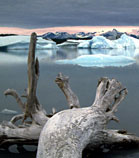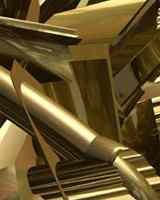|
Charles Kohlhase
–
photographer & digital artist
|

|
"
I have found that within every good photograph are many interior excellent photographs of smaller and smaller areas.
" |

|
| |
|
|
|
| |
How were you motivated to choose your particular field? |
| |
I wonder if art can be "in the blood". My great grandfather was a
superb painter and architect, and my grand uncle's B&W photographs of
the Great Smoky Mountains in 1924 convinced the Congress to make that
area in eastern Tennessee into a national park. Whenever I visited my
grandmother at her quaint octagonal house in Knoxville and saw many of
these works, listened to her exquisitely detailed stories each night
before falling asleep, and observed the beauty of the surrounding
natural area, I felt compelled to draw incessantly and also capture
images on film.
My senses were regularly flooded with the myriad textures within the
woods, as well as those upon the many fruits and vegetables within my
grandfather's garden. I can still recall seeing an indigo bunting one
spring in a small dogwood tree that grew near an area teeming with
butterflies. There was also the winter frost, the fallen buckeyes, and
the cottontails. The list is endless. Nature has an enduring way of
filling the heart and soul with lasting images of great value.
Scale model building (mostly of model airplanes and railroad cars)
further gave me the wish to become an architect, but the 5–year
university program was too expensive, so I eventually settled for a B.S.
in Physics instead. As the years passed, I did a lot of backpacking to
remote wilderness areas and always took along a camera. Later, when
computer graphics and 3D modelling finally blossomed, moving from
straight photography into digital art was a natural.
|
|

|
| |
|
|
|
| |
What can you share about your creative process? |
| |

|
|
The key to creating good photographs and digital art is to blend two
abilities – the ability to "see" the latent image at all levels of
scale, from the wide angle to the close–up, and then apply good
compositional techniques to capture an image in esthetic balance. I
have found that within every good photograph are many excellent interior
photographs of smaller and smaller areas. The mood of the light makes a
remarkable difference! At times, vast landscapes are appropriate. At
other times, only the barest of detail is best. Mies van der Rohe had
it right when he said, "Less is more." In the spring of 1998 after
unusually heavy rains, I did some of my best work using a close-up lens
on local flora and fauna.
Recently, I have become intrigued with "forging" virtual 3D sculpture on
a computer, then rotating it about to find a pleasing 2D view to
capture. There is unlimited scope here. The result is appropriate for
the new millennium. Making some of these sculptures out of real metals
would be nearly impossible, but not in the virtual world of shapes and
textures. It also allows order from the scientific world to join
composition from the artistic world. The use of your imagination, a
good 3D modelling program, and Adobe Photoshop can lead to interesting
results. Indeed, the mind, the heart, and the computer, as a team, can
enable the creation of anything that can be imagined.
|
|
| |
|
|
|
| |
What ideas do you have for a future human community on Mars?
|
| |
In addition to suggestions under the sciences section, the artist in me
recommends that the first Martian village be endowed with inspirational
architecture and breath-taking views from almost every room. It is also
important that ample bandwidth allow for streaming artistic images,
music, and educational materials in real time from great archives either
on Earth or brought to Mars from Earth. The use of light and color to
establish an upbeat ambience is important, but it must also be possible
to easily update and change lighting and color schemes. One should also
explore the inclusion of novel sports and dance that take advantage of
the low–g on Mars.
Though next to impossible to compete with the magnificent flora and
fauna of Earth (except by the lengthy process of terraforming), the
community must cleverly be made the envy of people back on Earth, an
enormous challenge to meet as long as Earth keeps its great wilderness
areas and its abundant water. The village layout and architecture must
also provide for expansion over time as the village grows. It must be
planned in from the start, not added later as an afterthought. But as
the village grows, the Martian environment must not be polluted as
humans have done here on Earth. Protecting the Earth's precious
environment remains our greatest imperative.
|
|

|
|




